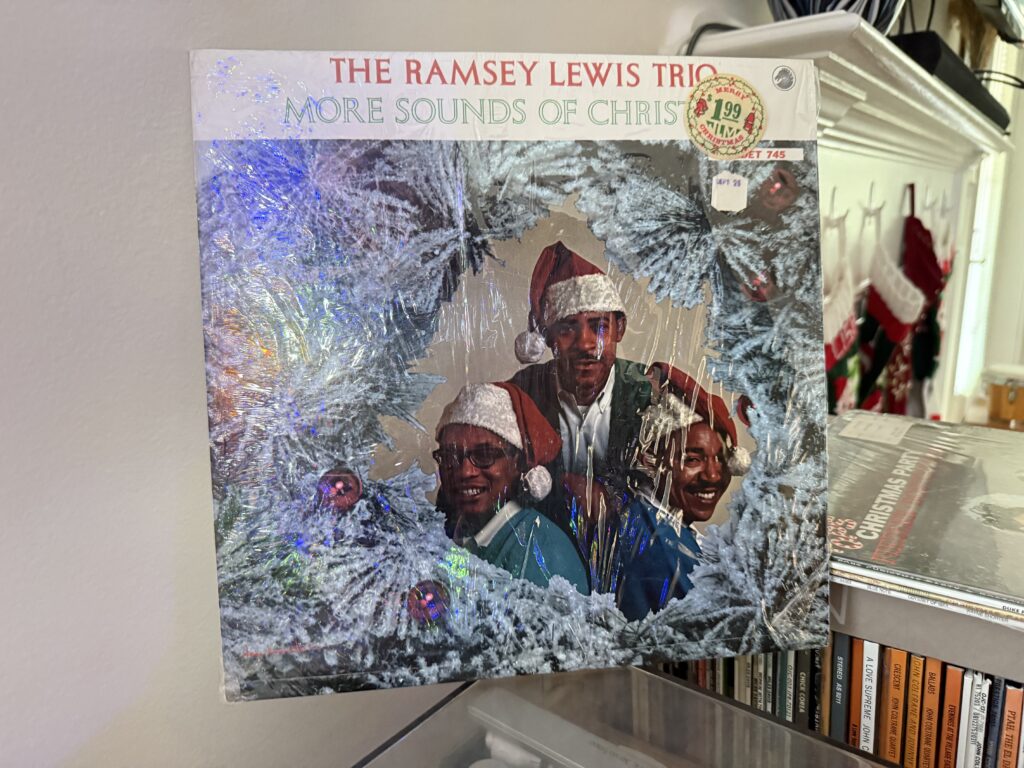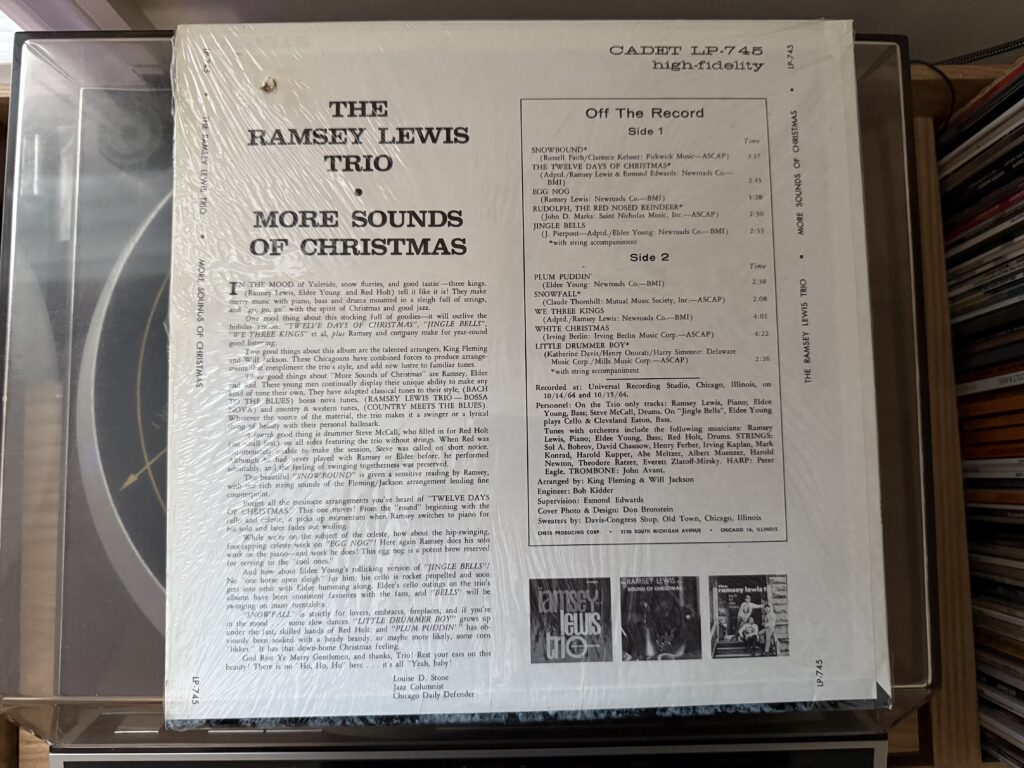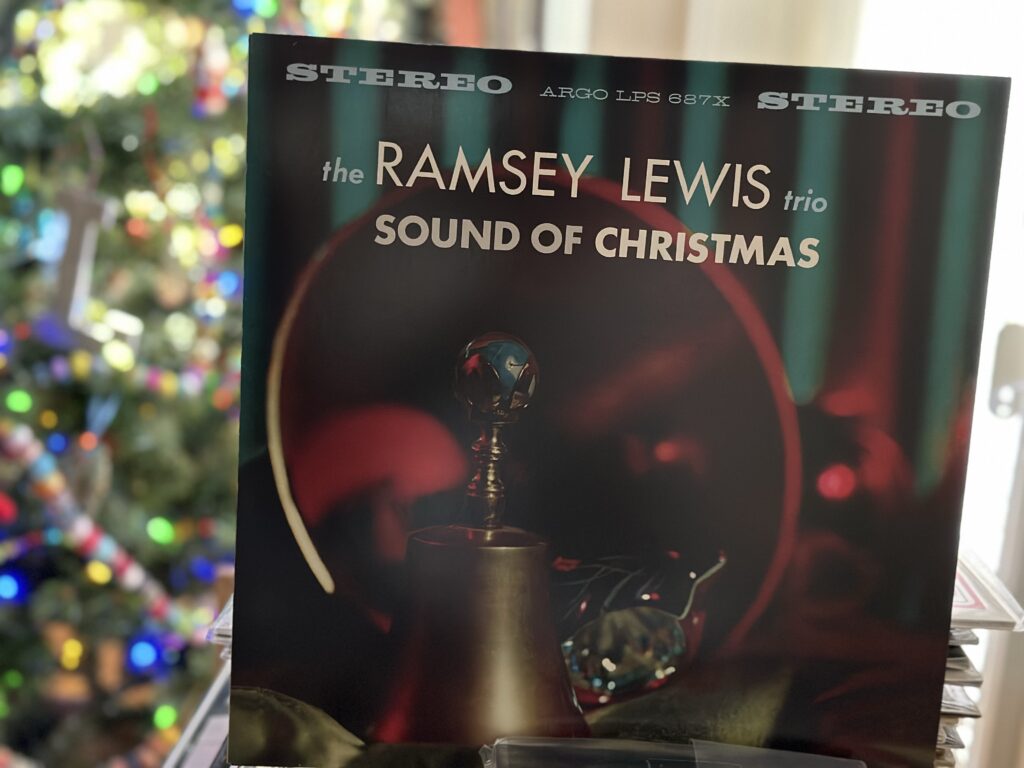
Album of the Week, December 7, 2024
There never seems to be enough time in the holiday calendar to write about all the Christmas music that there is. That’s partly because I like a wide variety of the stuff, of course, and partly because there is, in fact, an awful lot of it. Some Christmas albums are stone classics, and some … aren’t but are still pretty good.
Such is the case with today’s album, recorded in October 1964 and released just in time for that year’s holiday season. The title, a reference to the Lewis trio’s 1961 classic Sound of Christmas, screams “not putting in a lot of effort.” But this isn’t a run of the mill band going through the motions; this is the Ramsey Lewis Trio, and in fact the same trio that we heard on the 1961 recording, with Eldee Young on bass and Issac “Red” Holt on drums (with a little assist from Cleveland Eaton and Steve McCall on some of the tracks). The only difference is that Riley Hampton’s string arrangements don’t return; in their place are charts by bandleader King Fleming and saxophonist Will Jackson. The end product isn’t a stone classic, but it still has some great moments and is a good way to ease into the holiday.
“Snowbound,” a song by bandleader Russell Faith with Clarence Kehner made famous by Sarah Vaughan, starts us off in a contemplative mood. Ramsey Lewis performs the tune with subtle accompaniment by the string orchestra, then improvises while the orchestra takes the theme. The effect is meditative and evocative; one can imagine Lewis staring out a window into the falling snow… at least until the trombone solo crests at the peak of the bridge. (Fun fact: Trombonist John Avant went on to play in the Sun Ra Arkestra.)
From the slightly obscure mid-20th-century pop vein, we drop right into full holiday mode with “The Twelve Days of Christmas.” The arrangement takes us through day three with the strings, sleigh bells, and celeste only, before Lewis’s piano enters with the rest of the trio, playing a bluesy chorus. If you’ve sat through (or, ahem, sung) a few too many rounds of 12 Days, this arrangement is a pretty good way to allow you to reimagine it, albeit by discarding the structure and tune of the song pretty completely after the first minute.
The Lewis original “Egg Nog,” played just by the trio, is a full-throated twelve bar blues in which the band demonstrates their completely soulful mastery. Stride piano styles? Check, in the bridge. In-the-pocket drumming? Check. Deeply swung bass rhythms? Check. Only the celeste, played by Lewis on the intro and outro, takes this into Christmas music territory. It’s a good opportunity to whip up a batch of Charles Mingus’s eggnog recipe and sit by the Christmas tree.
What is there to say about “Rudolph, the Red-Nosed Reindeer” that hasn’t already been said? Well, as I was reminded watching the classic 1964 Christmas special last night, maybe it’s worthwhile remembering that the beloved Christmas mascot first found life in a poem published by Montgomery Ward in 1939, written by Robert L. May, a copywriter who was deeply in debt due to his cost of his dying wife’s medical treatments for cancer. The poem became a book due to May’s persistence, who convinced reluctant book publishers (who figured there wasn’t a market for a poem that already had six million copies in print thanks to Montgomery Ward) to take a chance on the children’s book market. At the beginning of the baby boom, this was a good bet; the book sold like hotcakes, and May was subsequently able to convince his sister’s husband, Johnny Marks, to write a song about the red-nosed reindeer. In the initial recording, performed by an initially reluctant Gene Autry, Rudolph completed his ascension to the highest stages of the secular American Christmas pantheon. —Okay, so maybe there was a little to say about the song after all. In this case, Lewis’s trio and the orchestra swing the song hard, driven by Red Holt’s monstrous syncopated drumming. (I listened to this song five times as I wrote this and am convinced I’ll be feeling that anticipatory downbeat in my dreams tonight.)
The trio seems to take the heavy swing of “Rudolph” as a challenge to see if they can swing “Jingle Bells” even harder. This is a showpiece for Eldee Young, who solos the entire song with what must have been a finger-bleeding pizzicato, accompanied by some pretty first class scat singing, taking us out of the first half. And it’s Young’s bass that takes us into his composition “Plum Puddin’” to open the second side. Lewis and the trio take us on a quick ride through what’s essentially a jam, with Lewis executing filigreed runs that veer into blue notes and back out again as Young and Holt lock into a tight rhythm that never lets up throughout.
“Snowfall,” a 1941 hit by Claude Thornhill and his orchestra, recaptures some of the mood of the album opener, but this time the strings are in control with less input from Lewis, until he starts jamming bits of what sound like a countermelody of his own “Sound of Christmas” at the end. Lewis’s trio arrangement of “We Three Kings” is more adventurous, driven both by Lewis’s bluesy piano and Holt’s heavily syncopated snare work. At the back of it all, Eldee Young’s bass weaves in and out with a descending line that echoes the magi’s journey all the way to the fleeting appearance of major-key tonality in the chorus, punctuated by huge drumrolls from Holt. Lewis closes it out in a minor mode with a trill on the minor third.
Lewis slides into Irving Berlin’s “White Christmas” with an eight-bar major key intro that suspends us on the fifth until he finally brings us down to the melody. It’s the sort of trick that “My Favorite Things”-era John Coltrane would have soaked in for half an hour or more; here it’s just another tool in Lewis’s belt. The rest of the performance is pretty standard for the trio, “just” outstanding bluesy swinging.
“Little Drummer Boy” must surely be the weirdest example of the interconnectedness of the 20th century; how many Christmas songs have an indirect connection to the Nazi takeover of Austria? It was the Trapp Family Singers (of “Sound of Music” fame) who first performed Katherine Davis’s “Carol of the Drum,” before Harry Simeone took it and rearranged it into the form we know today. Lewis does a little rearranging of his own, with the strings playing a repeated drone on the downbeat before Lewis takes an extended bluesy jam out of the end of the first verse, and stays in that vein until he glissandos right into a key change. The arrangement has him continue to jam his way through the end, until he picks up the melody once more as a tag at the end.

More Sounds of Christmas provides sufficient evidence that the persistence of the Ramsey Lewis Trio—ten years, twenty-something albums, a top ten hit—had as much to do with Young and Holt as it did with Lewis. We’ll listen to more of their recordings another time. but this week I recommend you spin this platter of bluesy holiday cheer as you’re dragging those ornaments out of storage. Next time we’ll flip over to something a little more traditional.
You can listen to this week’s album here:

